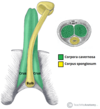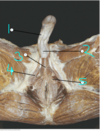Problems of the male reproductive system Flashcards
Which two structures pass through the prostate? [2]
prostatic urethra [1]
ejaculatory ducts [1]
Which of the following is the seminal gland
A
B
C
D
E
F

Which of the following is the seminal gland
A
B
C
D
E
F
Describe / draw the structure of the prostate [4]
4 main areas (3 of which are glandular)
- Peripheral zone
- Central zone
- Transition zone
- Anterior fibromuscular zone

Which part of the prostate is outlined
- Peripheral zone
- Central zone
- Transition zone
- Anterior fibromuscular zone

Which part of the prostate is outlined
- Peripheral zone
- Central zone
- Transition zone
- Anterior fibromuscular zone
Which part of the prostate is outlined
- Peripheral zone
- Central zone
- Transition zone
- Anterior fibromuscular zone

Which part of the prostate is outlined
- Peripheral zone
- Central zone
- Transition zone
- Anterior fibromuscular zone
Which part of the prostate is outlined
- Peripheral zone
- Central zone
- Transition zone
- Anterior fibromuscular zone

Which part of the prostate is outlined
- Peripheral zone
- Central zone
- Transition zone
- Anterior fibromuscular zone
Which area of the prostate is made from fibromuscular stroma? [1]
Anterior fibromuscular stroma

Histology xx
When conducting a benign prostate enlargement (hyperplasia) exam, which part of the prostate are you feeling?
What would indicate this compared to prostate cancer?
Posterior zone
BPE is enlarged - but remains smooth (cancer causes hard hard and lumpy)

Why is BPE problematic? [1]
What is the main cause of BPE? [1]
Urethra becomes compressed: narrows it.
Increased tesosterone / other testicular androgens. Also caused by oestrogens

What is outlined by the arrow [1] and circle [1] on this histology of prostate?

Arrow: (interdigitating) skeletal muscle fibers
Circle: paired ejaculatory ducts
The [] zone is the area commonly affected in benign prostate enlargement.
The transitional zone is the area commonly affected in benign prostate enlargement.
Explain mechanism of proliferation versus apoptosis in normal prostate vs BPE
Testosterone is converted to oestradiol in the stromal cells via the enzyme aromatase.
oestradiol then goes to the enzyme oestrogen receptor alpha and drives cell proliferation after it binds to in the stromal cells.
Oestradiol also goes into the epithelial cells and activate oestrogen receptor beta of the glands (in both the basal and luminal epithelial cells) and causes apoptosis
Testosterone can also enter directly into the basal epithelial cells converted to Dihydrotestosterone (DHT) by 5-alpha reductase in the epithelial cells. DHT can then pass into luminal epithelial, binds to androgen receptor and stops apoptosis
With BPE most of the oestradoil goes to the stomal cells and ERa and causes proliferation. Very little goes to ERbeta to cause apoptosis.
Due to increased Testosterone and therefore DHT: get more of androgen receptor, which drives luminal cells to hypetrophy.
Get proliferation of stromal cells and hypertrophy of epitheilial cells

FYI
All men over 40 have this
50% will develop histological hyperplasia
50% of these with have lower urinary tract symptoms (LUTS)
Some will develop significant enlarged prostate (EP)
Some will develop bladder outlet obstruction (BOO)

What are symptoms of BPE? [5]
Symptoms
* Weak or interrupted flow of urine
* Frequent urination (nocturia)
* Trouble urinating
* Pain or burning during urination (urine gets stuck in bladder - causes infection)
* Blood in urine or semen
SHITE = Slow stream, Hesitancy, Intermittent flow, Terminal dribbling, Emptying is incomplete.

How do you diagnose BPE? [5]
- Hx
- Digital rectal exam
- Ultrasound - measure the size of the prostate (also check isnt cancer)
- Biospy
- Blood test (prostate speficic antigen - although not that specific for BPE)

How can you treat BPE? [6]
α1-adrenergic blockers
* Relaxes smooth muscle in bladder neck and prostate improving urine flow rate
5-α-reductase inhibitors
* 2 isoforms type I and type II (type II predominant prostatic reductase) blocks the formation of DHT.
Dutasteride
Finasteride
Combinations
Surgery
* Open prostatectomy (for very large prostates, >75g)
* UroLift
Laser ablation
Transurehral microwave
High energy ultrasound therapy

What do need to think about with regards to BPE and prostate cancer? [1]
How can you distinguish between the two? [1]
Symptoms of BHP may be similar to prostate cancer
PSA (if raised) tends to be much higher than in BPH
Describe the relationship of direct and indirect inguial hernias to inferior epigastric vessels [2]
Direct: medial to IPV
Indirecct: lateral to IPV

What are the borders of Hesselbachs triangle? [3]
Which type of inguinal hernias pass through Hesselbachs triangle? [1]
Medial – lateral border of the rectus abdominis muscle.
Lateral – inferior epigastric vessels.
Inferior – inguinal ligament.
Direct inguinal hernias pass through

Which side is more common to have indirect inguinal hernia in? [1]
Right = 80%
What causes indirect inguinal hernia? [1]
How do you treat? [1]
processus vaginalis doesnt close - means loop of intestine can fall into the scrotum
Treat with surgery
The inferior epigastric artery forms the lateral border of inguinal triangle. From which artery does it arise?
Inferior mesenteric
External pudendal
Common iliac
External iliac
The inferior epigastric artery forms the lateral border of inguinal triangle. From which artery does it arise?
Inferior mesenteric
External pudendal
Common iliac
External iliac
Which type of hernia occurs through Hesselbach’s triangle?
Direct inguinal
Incarcerated femoral
Paramedian
Deep inguinal
Which type of hernia occurs through Hesselbach’s triangle?
Direct inguinal
Incarcerated femoral
Paramedian
Deep inguinal
Which structure forms the medial border of the inguinal triangle?
External oblique
Linea alba
Rectus abdominis
Transversus abdominis
Which structure forms the medial border of the inguinal triangle?
External oblique
Linea alba
Rectus abdominis
Transversus abdominis

Which of the following zone of prostate surrounds the proximal urethra?
Peripheral zone
Central zone
Transition zone
Anterior fibromuscular stroma
Which of the following zone of prostate surrounds the proximal urethra?
Peripheral zone
Central zone
Transition zone
Anterior fibromuscular stroma
Which of the following zone of prostate surrounds the ejaculatory ducts?
Peripheral zone
Central zone
Transition zone
Anterior fibromuscular stroma
Which of the following zone of prostate surrounds the ejaculatory ducts?
Peripheral zone
Central zone
Transition zone
Anterior fibromuscular stroma

.
.
what are the erectile tissues in males? [4]
what are the erectile tissues in males? [2]
- *corpus spongiosum (**mouth of insect)
- *corpus cavernersa** (eyes of insect)
- *bulbospongiosus (**superifical to corpus spongiosum)
- *ischiocavernosus (**superifical to corpus spongiosum)

which of the following is the urethra found in?
corpus spongiosum
corpus cavernersa
bulbospongiosus
ischiocavernosus
which of the following is the urethra found in?
corpus spongiosum
corpus cavernersa
bulbospongiosus
ischiocavernosus

which of the following is this highlighted muscle?
corpus spongiosum
corpus cavernersa
bulbospongiosus
ischiocavernosus

which of the following is this highlighted muscle? **corpus spongiosum** corpus cavernersa bulbospongiosus ischiocavernosus
which of the following is this highlighted muscle? corpus spongiosum corpus cavernersa bulbospongiosus ischiocavernosus

which of the following is this highlighted muscle? corpus spongiosum **corpus cavernersa** bulbospongiosus ischiocavernosus
what is highlighted here? [1]

crux of penis
which of the following is this highlighted muscle?

which is this muscle?
corpus spongiosum
corpus cavernersa
bulbospongiosus
ischiocavernosus

which is this muscle?
corpus spongiosum
corpus cavernersa
bulbospongiosus
ischiocavernosus
Which part of the urethra is located in the corpus spongiosum of the penis? [1]
Acceptable responses: spongy, spongy part, penile
which 1-5 is the corpus cavernersa
1 2 3 4 5

which 1-5 is the corpus cavernersa
**1** 2 3 4 5

which 1-5 is the bulbospongiosus
1 2 3 4 5

which 1-5 is the bulbospongiosus
1 2 **3** 4 5

which 1-5 is the corpus spongiosum
1 2 3 4 5

which 1-5 is the corpus spongiosum
1 **2** 3 4 5

which 1-5 is the Superficial transverse perineal muscle
1 2 3 4 5

which 1-5 is the Superficial transverse perineal muscle
1 2 3 4 **5**

which 1-5 is the Ischiocavernosus
1 2 3 4 5

which 1-5 is the Ischiocavernosus
1 2 3 **4** 5

what are the 3 nerve branches of the perineum? [3] what do they supply [3]
Inferior rectal - supplies the external anal sphincter and inferior anal canal
Perineal - supplies the anterior perineum
Dorsal nerve of penis/clitoris - supplies the external genitalia
The pudendal nerve can be located clinically by palpating for the WHAT? [1]
The pudendal nerve can be located clinically by palpating for the ischial spine, as the nerve loops around it posteriorly.
A young man attends his GP because he has been experiencing erectile dysfunction. Fibres from which branch of the autonomic nervous system are responsible for genital erection? [1]
Acceptable responses: parasympathetic, parasympathetic nervous system
Erectile dysfunction can be subclassified as WHAT? [3]
Complete inability to have an erection
Inconsistent ability to achieve an erection
Ability to have short-term erections
Label A-G


Explain bloodflow mech. for creating an erection
During an erection: get relaxation of smooth muscle in corpus cavernosa.
Compresses venous outflow: stops blood getting out = maintains erection

Explain biochem mechanism for getting an erection
NANC neuron comes down: Increases nitric oxide. Diffuses into smooth muscle, where guanyll cyclase converts GTP to cGMP: creates less Ca2+ creates relaxation
Also get eNOS from blood vessels creating more NO that activates

Which drugs would you use to treat erectile dysfunction? [3]
Sildenafil (viagra) a PDE-5 inhibitor
Vardenafil (levitra), Tadalafil (cialis) also PDE-5 inhibitors
How do ED treatments work? [2]
- Sildenafil inhibits the action of phosphodiesterase (PDE) type 5,
- increasing the intracellular concentration of cGMP.
How do ED treatments work? [2]
- Sildenafil inhibits the action of phosphodiesterase (PDE) type 5,
- **increasing the intracellular concentration of cGMP. **
Whats a non-pharmalogical treatment of ED?
penile prosthesis

What is Peyronie’s disease? [1]
What is it caused by? [1]
What are treatment options? [2]
Peyronie’s disease = Bent Penis
Caused by: scar tissue forming in the shaft of the penis. Painful erections!
Treatment:
Surgical
Non-surgical:
* stretching
* topical verapamil (calcium channel blocker),
* Para-aminobenzoate (type of B vitamin: increase o2 to tissues to reduce scar tissue forming)
What is varicocele?
Which testis does it occur in and why?
Varicose veins of the scrotum (pampiniform venous plexus)
Very common 10-15% and always in the left testis
Usually harmless but can be a cause infertility
On the left because venous drainage takes right angle into left renal vein, but on the right goes to IVC. Causes greater backflow into the left



